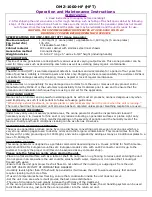
23
M
INI
-S
PACE
EC I
NSTALLATION
, O
PERATION
AND
M
AINTENANCE
M
ANUAL
4.0
MAINTENANCE
4.1
Periodic General Maintenance
Systematic, periodic general maintenance of the Mini-Space
EC unit is recommended for optimal system performance.
General maintenance should include, but is not limited to, the
following: replacing fi lters and humidifi er cylinders, tightening
electrical connections, checking the condensate line to
ensure it is free of debris, cleaning the interior of the unit,
inspecting the unit’s components visually, checking the level
of refrigerant and ensuring no moisture is in the refrigerant.
Use copies of the Periodic General Maintenance Checklist
at the back of this manual to record periodic general
maintenance inspections. For assistance, contact the STULZ
Product Support Group. Ensure adherence to all safety
statements while performing any type of maintenance.
WARNING
This equipment should be serviced and repaired by
a journeyman or a qualifi ed refrigeration technician
only.
WARNING
This unit employs high voltage equipment with
rotating components. Exercise extreme care to avoid
accidents and ensure proper operation.
Hazardous voltage will still be present inside the electric box
at the motor start protectors and circuit breakers, even with
the unit turned off at the microprocessor controller. To isolate
the unit for maintenance, turn off power at the main power
disconnect switch. Always disconnect main power prior to
performing any service or repairs.
WARNING
Turn off power to the unit unless you are performing
tests that require power. With power and controls
energized, the unit could begin operating
automatically at any time. To prevent personal injury,
stay clear of rotating components, as automatic
controls may start them unexpectedly.
WARNING
Fluorophosgene, a deadly poisonous gas, is
generated when R410A refrigerant is exposed
to flame. Always ensure adequate ventilation
during refrigeration repairs.
WARNING
Always recover all refrigerant prior to any system
repairs. Failure to do so may result in system over
pressurization and rupture.
4.1.1 Filter
The filter is usually the most neglected item in an air
conditioning system. To maintain effi cient operation, the fi lter
should be checked at least monthly and replaced as required.
Refer to Section 4.3.4.5 for fi lter replacement instructions.
NOTE
Air cleanliness varies from one space to the next.
Establish a frequency for checking fi lters based on
the conditioned space.
4.1.2 Drain
Pan
To ensure proper drainage, inspect the drain pan regularly.
Make sure the drain pan outlet is always free of debris and
ensure the drain pan does not leak.
4.1.3 Coils
Coil(s) should be inspected semiannually and cleaned as
required following standard coil cleaning practices. Using
a brush, clean the coil fins of all debris that will inhibit
airfl ow. This can also be done with compressed air or with a
commercial coil cleaner. Check for bent or damaged coil fi ns
and repair as necessary. Check all piping for signs of leaks.
4.1.4 Heat/Reheat
The heat/reheat equipment should be inspected semi-
annually to ensure it is operational. If you have electric heat/
reheat, inspect the heating elements to ensure they are free
of debris.
4.1.5 Humidifi er
The steam cylinder has a limited lifetime and must be replaced
periodically. Because water conditions and humidifi er usage
rates vary greatly, it is difficult to establish intervals for
changing the cylinder. Individual maintenance schedules
must be determined for each location, based upon periodic
examination of the humidifi er. A change cylinder light on the
humidifi er cabinet will fl ash yellow in a repeating four-fl ash
pattern when the cylinder requires replacement.
See section 4.3.4.4 for detailed instructions on changing
the cylinder.
CAUTION
Failure to replace the cylinder at the end of cylinder
life may result in humidifi er damage.














































